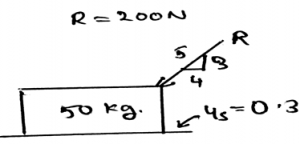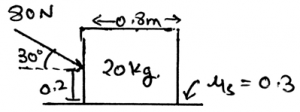This set of Engineering Mechanics Multiple Choice Questions & Answers (MCQs) focuses on “Characteristics of Dry Friction – 1”.
1. ____________ is the phenomena that resist the movement of the two surfaces in contact.
a) Friction
b) Motion
c) Circular movement
d) Rotation
View Answer
Explanation: The friction is the phenomena that define that there is a resistance which is present there between the two surfaces. The two surfaces are in contact and the friction applies at that surface only, resisting the motion of the surface.
2. The frictional force always acts ____________ to the surface of the application of the friction.
a) Tangential
b) Perpendicular
c) Parallel
d) Normal
View Answer
Explanation: The friction is the phenomena that defines that there is a resistance which is present there between the two surfaces. This friction is applied tangentially to the surfaces in contact. Thus the main thing is that the forces on both of the surfaces act as a tangential to each other.
3. Dry friction is also called _____________
a) Column Friction
b) Coulomb Friction
c) Dry column friction
d) Surface friction
View Answer
Explanation: The dry friction is acted upon the surfaces. And they are tangential to each other. As we know the friction is the phenomena that define that there is a resistance which is present there between the two surfaces. The dry friction is also termed as the Coulomb friction as it was given by C.A. Coulomb.
4. Who gave the concept of Dry friction?
a) C.A. Coulomb
b) GA. Coulomb
c) C.P Coulomb
d) Albert Einstein
View Answer
Explanation: The dry friction is also termed as the Coulomb friction as it was given by C.A. Coulomb. And they are tangential to each other. As we know the friction is the phenomena that defines that there is a resistance which is present there between the two surfaces.
5. At what conditions the dry friction occurs between the surfaces in contact?
a) When there is no lubricating fluid
b) When there is no friction fluid
c) When there is no adhesive fluid
d) When there is no cohesive fluid
View Answer
Explanation: When there is no lubricating fluid present between the surfaces in contact, the dry friction occurs. Thus as the name suggests dry friction. When there is no liquid present over there the surfaces are going to be said dry only. Thus the term dry friction.
6. The phenomena of horizontal pull and push explain what?
a) Theory of friction
b) Theory of relativity
c) Theory of action
d) Theory of forces
View Answer
Explanation: As we know that when there is no lubricating fluid present between the surfaces in contact, the dry friction occurs. This is the phenomena that defines that there is a resistance which is present there between the two surfaces. Thus the pull and push phenomena explain the theory of friction.
7. Theory of friction is explained over a block of weight W. Which of the following is the property of the surface on which block is present?
a) Non-rigid
b) Coloured red
c) Having density in negative
d) The motion of that block is always horizontal
View Answer
Explanation: The block used to explain the theory of friction is a used in a deformable surface. As we know that the theory of friction says that when there is no lubricating fluid present between the surfaces in contact, the dry friction occurs. Thus to show the same experiments are done over a non-rigid/deformable surface.
8. The block used to explain the theory of friction is kept over non-deformable surface.
a) True
b) False
View Answer
Explanation: The block used to explain the theory of friction is used in a deformable surface. As we know that the theory of friction says that when there is no lubricating fluid present between the surfaces in contact, the dry friction occurs. Thus to show the same experiments are done over a non-rigid/deformable surface.
9. In the explanation of the theory of friction, the block used to have an assumption. That is the upper portion of the block is considered to be rigid.
a) True
b) False
View Answer
Explanation: The block used to explain the theory of friction is placed on a deformable surface. As we know that the theory of friction says that when there is no lubricating fluid present between the surfaces in contact, the dry friction occurs. Thus to show the same, experiments are done over a non-rigid/deformable surface which is having a rigid shape.
10. The free body diagram used to explain the theory of dry friction is having ___________ distribution of both the normal forces and frictional surface.
a) Uneven
b) Even
c) Uniform
d) Equal
View Answer
Explanation: As we know that when there is no lubricating fluid present between the surfaces in contact, the dry friction occurs. This is the phenomena that define that there is a resistance which is present there between the two surfaces. Thus the pull and push phenomena explain the theory of friction. Thus the free body diagrams are having an uneven distribution of the forces.
11. For equilibrium the normal forces acts in which direction in the free body diagrams?
a) Vertically Upward
b) Vertically Downward
c) Horizontally Right
d) Horizontally Left
View Answer
Explanation: As the loads are being acting in the downward direction. Thus to make the forces balance, the normal forces act in the vertically upward direction. As we know that when there is no lubricating fluid present between the surfaces in contact, the dry friction occurs. This friction magnitude is taken out from these normal forces.
12. What is not the condition for the equilibrium in free body diagram for calculation of the normal forces?
a) ∑Fx=0
b) ∑Fy=0
c) ∑Fz=0
d) ∑F≠0
View Answer
Explanation: For the equilibrium in the three dimensional system of axis we have all the conditions true as, ∑Fx=0, ∑Fy=0 and ∑Fz=0. Also we have the summation of the forces equal to zero. Which is not a non-zero value.
13. We first make equilibrium equations of the body by considering all the three dimensional forces acting on the section chosen and then the free body diagram is made and solved.
a) The first part of the statement is false and other part is true
b) The first part of the statement is false and other part is false too
c) The first part of the statement is true and other part is false
d) The first part of the statement is true and other part is true too
View Answer
Explanation: We first make the free body diagram and then we make the equilibrium equations to satisfy the given conditions. This helps us to solve the question easily. As this reduces the part of imagination and increases accuracy too.
14. Calculate the product of normal force and the coefficient of friction between the body and the surface.
a) 183N
b) 116N
c) 100N
d) 180N
View Answer
Explanation: The net forces acting on the body is shown with the help of the resultant forces. There are two types, first the frictional and the second is normal. This is because the resultant forces have the sum of all the forces which are acting in the direction which is same.
15. Determine the distance between the points of action of the forces, that is the normal force and the self-weight force in the given figure.
a) 9.08mm
b) 9.08cm
c) 9.08m
d) 9.8mm
View Answer
Explanation: The net forces acting on the body is shown with the help of the resultant forces. There are two types, first the frictional and the second is normal. This is because the resultant forces have the sum of all the forces which are acting in the direction which is same.
Sanfoundry Global Education & Learning Series – Engineering Mechanics.
To practice all areas of Engineering Mechanics, here is complete set of 1000+ Multiple Choice Questions and Answers.
If you find a mistake in question / option / answer, kindly take a screenshot and email to [email protected]


